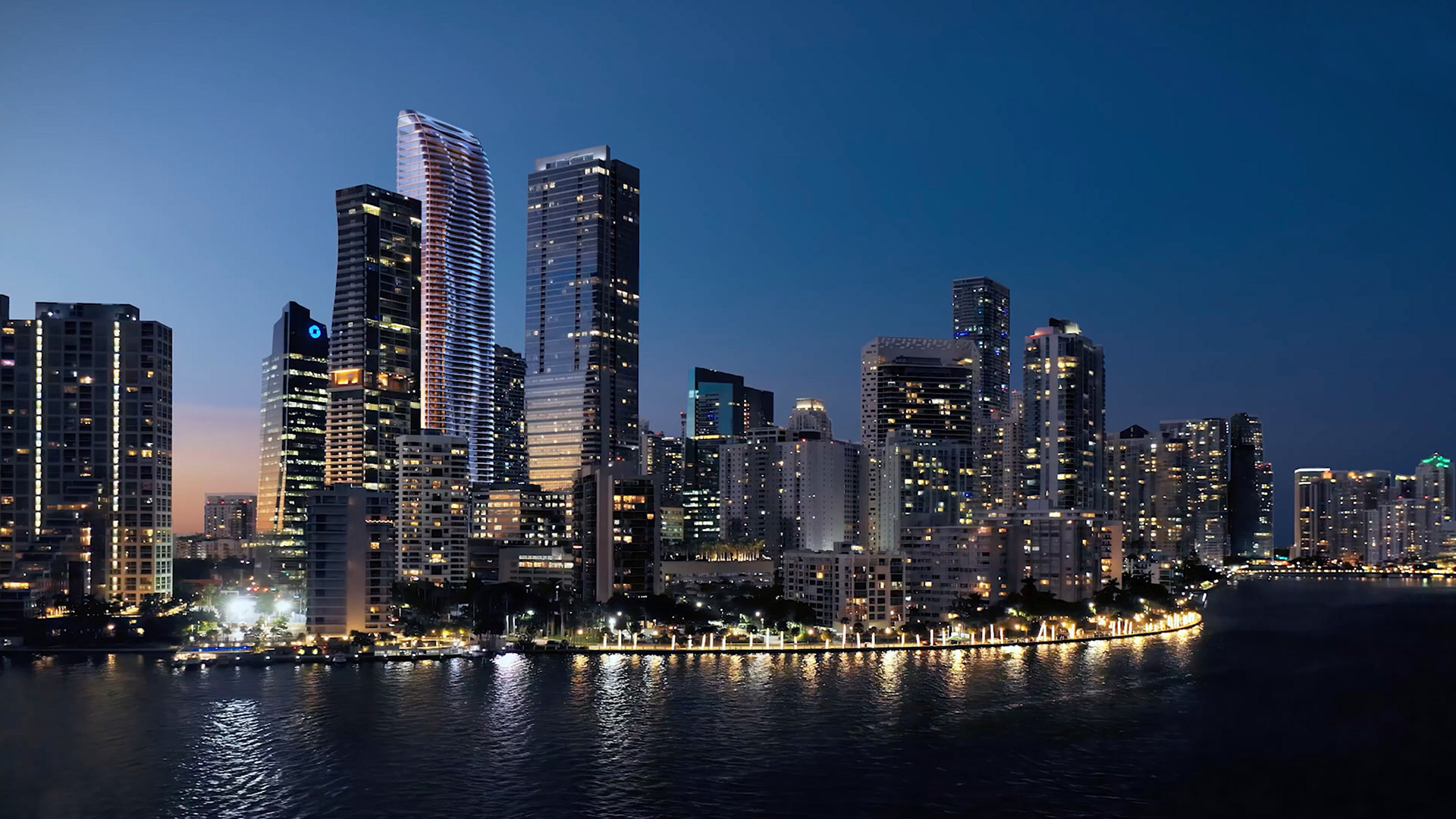
Florida’s sunshine has long been one of its most abundant resources, and now a real estate developer is harnessing that light in a Miami residential high-rise.
Developer Ytech has started construction on an 860-foot-tall tower set to feature sun-absorbing technology that the builder is touting as a groundbreaking residential building, partially powered by solar energy. The Residences at 1428 Brickell in the heart of Miami’s financial district is designed to have photovoltaic glass on one side, generating up to 175 megawatts of clean energy annually.
The tower is the latest in a growing list of ultra-luxury condominiums climbing up the Miami skyline. Developers are taking advantage of Miami’s elevated prominence after the 2020 pandemic saw an influx of high-net-worth relocations and company expansions to the city and “want to provide what buyers want,” said Alicia Cervera Lamadrid, managing partner of brokerage Cervera Real Estate, in an interview.
Lamadrid is leading sales at 1428 Brickell for Cervera Real Estate. Her team has previously handled sales for some of Miami’s newest ultra-luxe towers, including the $1 billion Aston Martin Residences that opened earlier this year.
And buyers seemingly want more square footage. The Residences at 1428 Brickell is set to feature 195 units when it opens sometime in 2028. Each residence comes fully furnished and ranges from two to four bedrooms, spanning 1,800 square feet to 4,000 square feet for a standard unit. Penthouses range from 4,000 square feet to 10,000 square feet.
Prices for standard units range from $3 million to $7 million, while the cheapest available penthouse starts at $8 million. A seven-bedroom penthouse complete with 30-foot high ceilings, nine bathrooms and two Biscayne Bay-facing balconies is listed for $60 million. More than 50% of the units are presold.
‘Vertical city’
According to the latest report from brokerage ISG World, there are 15,575 condo units in various stages of development, representing 51 projects across downtown Miami. In the Brickell financial district, there are 16 projects, most of them towers, within walking distance of the Residences at 1428 Brickell.
“Miami has become a vertical city, and a city with all of the opportunities and some of the challenges of a dense city,” said Lamadrid.
Despite the number of condo projects underway across the city, there is a lack of bigger units being built, said Lamadrid. Luxury condo towers with larger three- and four-bedroom units that are more in demand as families move to the city center are few and far between.
“There is not that much inventory given the amount of growth we’ve had” for larger units created for families at the top-tier luxury condos, Lamadrid said.
Lenders seem willing to provide the capital for more condominiums across the market, including a string of over half-a-billion-dollar loans for some of Miami’s biggest towers over the past year. Banks are “comfortable” lending to condos thanks to the “significant share” of presales done prior to breaking ground, said Juan Arias, CoStar’s director of market analytics for South Florida.
For 1428 Brickell, Ytech obtained a $78 million loan in March from Miami-based Linkvest Capital to refinance the property’s original $20 million acquisition loan.
Solar backbone
Distinguishing 1428 Brickell from its neighbors like Cipriani Residences and Mercedes-Benz Places, however, is what Ytech refers to as the 70-story tower’s solar backbone. The skyscraper is designed to be partially solar-powered from the 500 photovoltaic-integrated windows on the western façade. Residents’ views of Biscayne Bay, facing east, are to remain unobstructed.
This solar backbone is replacing the use of 3,000 barrels of oil that would normally be needed to generate the same amount of energy. It’s expected to eliminate 4,700 tons of carbon dioxide byproduct. The solar windows are entirely funded by Ytech, and the developer did not receive any tax incentives for their inclusion.
Though using solar panels or photovoltaic glazing for commercial real estate projects is nothing new — Miami’s Kaseya Center added photovoltaic skylights to the entertainment venue about a decade ago — Ytech’s CEO Yamal Yidios said he doesn’t know of any other luxury, high-rise residential tower with the technology integrated within a building’s façade.
The solar cells are to be directly integrated into the tower’s glass, making their lifespan the same as the window itself as they blend into the rest of the tower’s architecture, Miami-based Ytech said in an announcement.
The company decided to use photovoltaic glass after researching over 250 luxury residential towers and hotels around the world and speaking to dozens of architects and designers, Yidios said.
“We hope to see it also compel future developments to prioritize sustainability by incorporating their own [photovoltaic] glass into their structures, or through researching and developing their own innovative ideas to reduce energy consumption,” Yidios said.
The condominium “was designed to maximize holistic wellness, environmental consideration and well-being,” Yidios said.
The tower is expected to include over 80,000 square feet of indoor and outdoor amenities, including three pools, a 10,000-square-foot gym and weight room, a two-story wine and fine art lounge, high-end office suites and a private dining room equipped with a Vaselli kitchen, a one-of-a-kind offering from the Italian design studio.